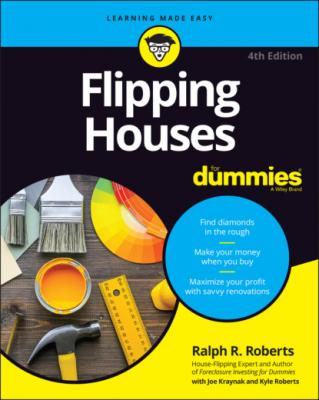ТОП просматриваемых книг сайта:
Flipping Houses For Dummies. Ralph R. Roberts
Читать онлайн.Название Flipping Houses For Dummies
Год выпуска 0
isbn 9781119861034
Автор произведения Ralph R. Roberts
Жанр Недвижимость
Издательство John Wiley & Sons Limited
Suppose that you have a $200,000, 30-year mortgage at 8 percent with a monthly house payment of $1,467.53. You’ve owned the house for 10 years and still owe $175,000 on the mortgage. If you refinance for $250,000 (the home’s current appraised value) and take out a 20-year mortgage at 4.5 percent, now you have a house payment of $1,581.62 and you walk away with the $75,000 equity that was locked up in the house (the refinanced amount of $250,000 minus the $175,000 to pay off the old mortgage) to use as investment capital.
Well, that certainly looks rosy, but what have you lost in the transaction?
You now owe $250,000 on your home and have no equity built up in it.
Your new house payment is $114 more than your previous house payment.
Over the life of the loan, you’re scheduled to pay $27,360 more than you would have paid by sticking with your original mortgage.
In short, you’ll pay $27,360 over the course of 20 years to gain access to $75,000 now. But think of it this way — by putting your equity to work for you in successful flips, you may be able to turn that $75,000 into far more than $27,360. In fact, you might make that much money and then some on your first flip!
Of course, you don’t have to unleash all the equity in your home. To build on the previous example, you could take out a 20-year, $225,000 loan at 4.5 percent, with a monthly payment of $1,423.46, freeing up $50,000 in equity, or a 20-year, $200,000 loan at 6 percent with a monthly payment of $1,265.30, freeing up $25,000 in equity. Your choice depends primarily on your comfort level and risk and debt tolerance. The more equity you leave in the house, the greater your cushion, but that also means less investment capital to work with.
Don’t refinance into a loan that has a prepayment penalty — a provision in the loan agreement stating that if you pay off the balance of the loan early, you have to pay extra. The amount you’re required to pay is usually a percentage of the balance at the time you pay off the loan or a certain number of months of interest. The purpose of a prepayment penalty is to ensure that the lender receives some compensation for its work.
Don’t refinance a fixed-rate mortgage into a new adjustable-rate mortgage. Adjustable-rate mortgages are unpredictable; you can get burned by a sudden increase in the interest rate and your monthly payments.
Taking out a home equity loan or line of credit
Taking out a home equity loan or line of credit unlocks the equity in your home without affecting your current mortgage:
A home equity loan provides you with a single chunk of money — a one-time payment to you.
A home equity line of credit enables you to borrow only what you need and pay interest on only what you borrow, making this option attractive for financing renovations. It’s sort of like a credit card, often with a higher credit limit and lower interest rate.
Taking out a home equity loan or line of credit may be a better financial choice than refinancing your current mortgage in the following situations:
The interest rate on your first mortgage is low compared to current interest rates. If your current mortgage interest rate is 4.5 percent, refinancing to a mortgage at 8 percent is probably a poor choice. Keeping that mortgage in place and taking out a separate home equity or line of credit loan may be a better choice.
You’ve been paying on your first mortgage for several years. With every payment you make, you pay more on principal and less on interest, so if you’ve been paying 15 years on a 30-year mortgage, refinancing now may cost you in the long run. Again, a home equity loan or line of credit may be the better option.
You can quickly flip the property you’re investing in and pay off the home equity loan or line of credit. Assuming that the loan has no prepayment penalty, if you can unlock the equity in your home and then quickly pay back the money, you retain your home’s equity.
Cracking open your retirement nest egg
Newcomers are often attracted to real estate investments because they may result in a higher percentage return than stocks or bonds. In addition, real estate gives you more control over the performance of your investment. In the case of flipping houses, if you do it right and don’t fall victim to a burst housing bubble, you stand to earn 20 percent or more on each house you flip. You’re not likely to see that sort of return on stocks and bonds!
Because real estate is an investment opportunity that’s as legitimate as stocks and bonds, some real estate investors are choosing to structure their IRAs (or at least a portion of them) around real estate investments. In other words, you can convert your IRA into a self-directed IRA and use the money in your retirement account to fuel your flips. Consult your accountant and your personal finance specialist to determine whether this option is one you want to explore and to work out all the details if you choose to go this route. It’s risky, but so is the stock market.
www.trustetc.com). The people there are helpful, offer webinars, and try to educate you on how to use a self-directed IRA as a tool to buy and flip real estate.

